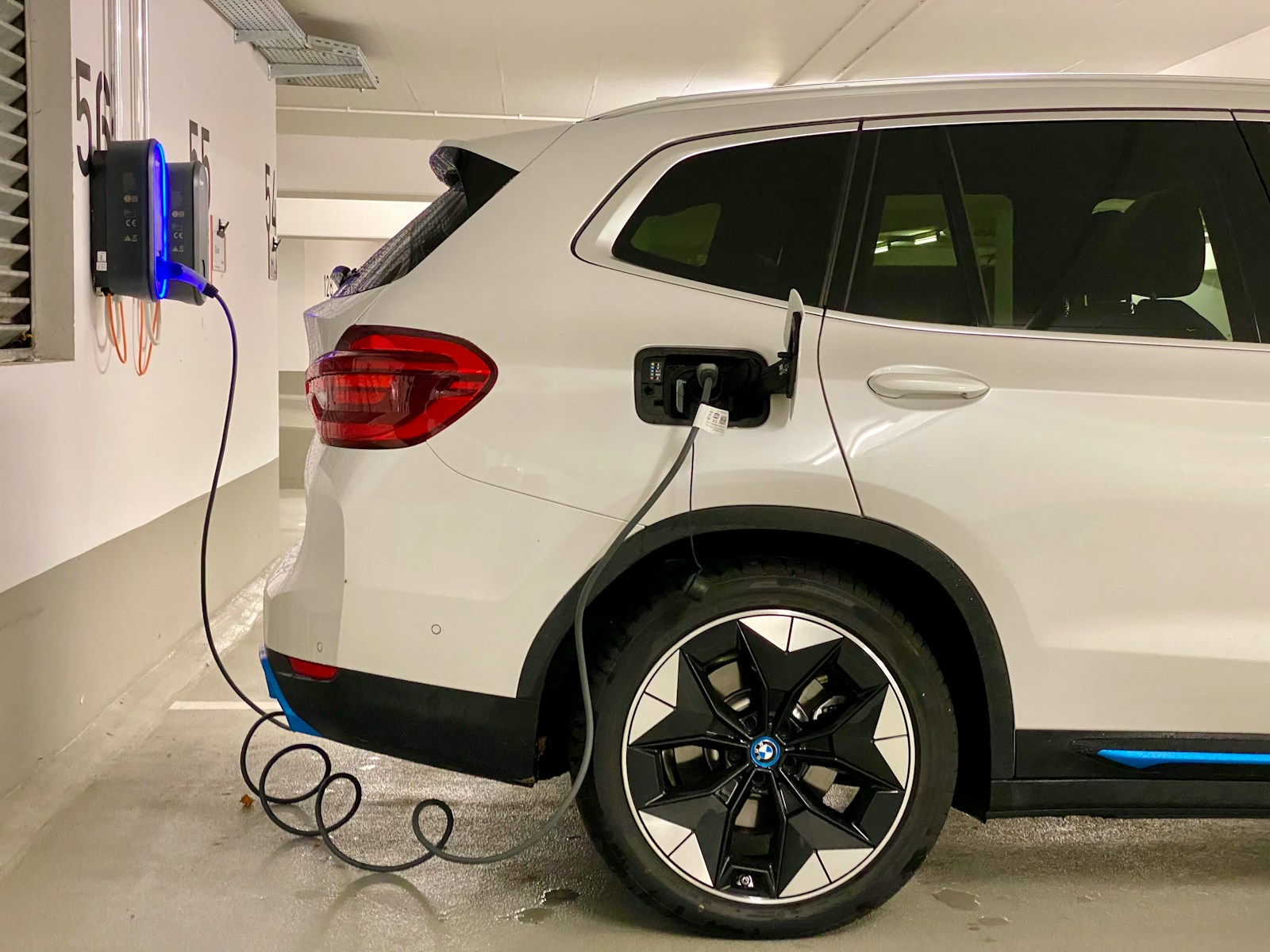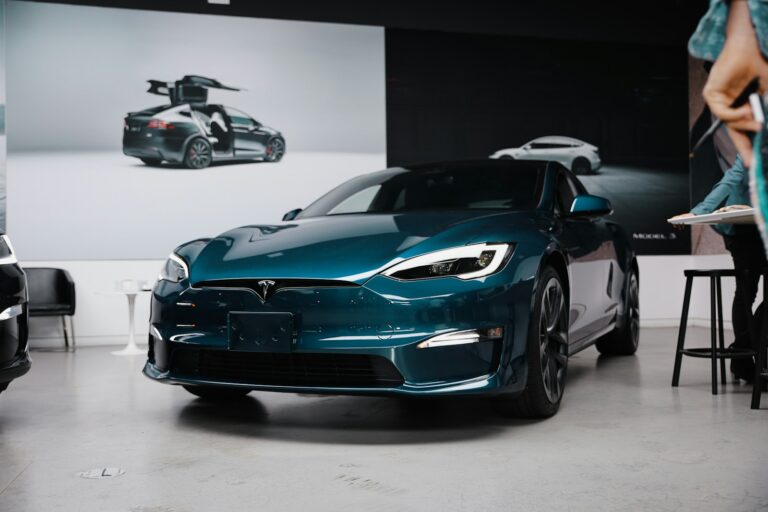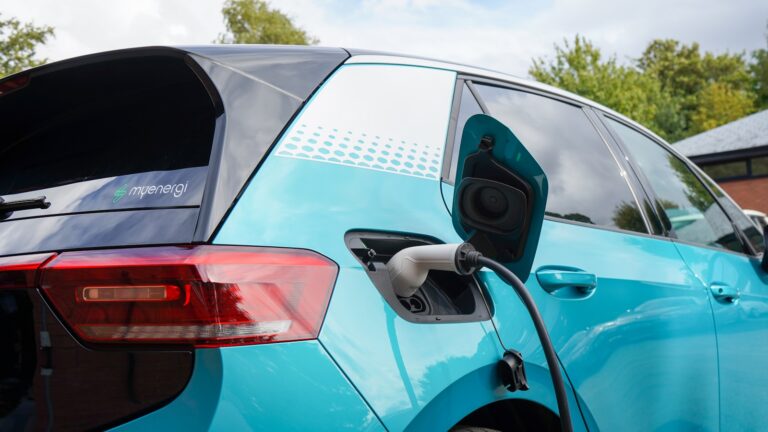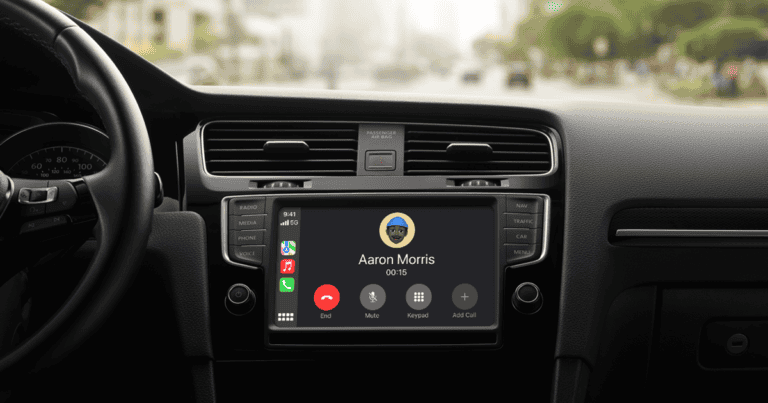
Electric cars are transforming our roads with their quiet hum and eco-friendly reputation. Unlike traditional cars that burn gasoline, electric vehicles (EVs) run on electricity stored in batteries. Electric cars work by using battery packs to power an electric motor, which turns the wheels and moves the vehicle forward without needing gasoline or producing tailpipe emissions.
When you drive an electric car, you’re essentially operating a big battery on wheels. The process starts when you plug your car into a charging station or wall outlet. Electricity flows into the battery pack, storing energy for later use. When you press the accelerator, the car’s computer sends power from the batteries to the electric motor, which creates motion much more efficiently than gas engines do.
The simplicity of EVs might surprise you. They have fewer moving parts than conventional vehicles, which means less maintenance. No oil changes, no transmission issues, and no exhaust system to worry about. Instead of visiting gas stations, you’ll charge at home or at public charging stations, changing not just how you drive but how you think about refueling altogether.
How Electric Cars Work
Electric vehicles (EVs) are transforming the automotive world — replacing engines, exhaust pipes, and fuel tanks with batteries, motors, and software. To understand how EVs work, let’s break down their core components, power flow, and unique driving systems.
🚗 1. The Basics: What Makes an Electric Car “Electric”?
Unlike traditional vehicles powered by internal combustion engines (ICEs), electric cars use electricity stored in batteries to power an electric motor.
This motor converts electrical energy into mechanical energy, which drives the wheels.
Key differences from gasoline cars:
- No fuel tank → Battery pack
- No engine → Electric motor
- No exhaust → Zero emissions
- No gear shifting → Single-speed transmission
🔋 2. The Power Source: Battery Pack
The battery pack is the heart of an EV. It stores energy in lithium-ion cells, similar to those in smartphones but on a much larger scale.
Functions:
- Supplies power to the electric motor and electronics
- Recharges via plug-in charging or regenerative braking
- Managed by a Battery Management System (BMS) to ensure safety, efficiency, and longevity
Battery capacity is measured in kilowatt-hours (kWh). A higher kWh rating means a longer driving range.
⚙️ 3. The Electric Motor: Converting Energy into Motion
The electric motor is what actually moves the car. It uses electromagnetic fields to turn electrical energy into rotational motion.
Two main types of motors:
- AC induction motor (used by Tesla and others)
- Permanent magnet synchronous motor (PMSM) (common in many EVs)
Advantages:
- Instant torque for quick acceleration
- Fewer moving parts → less maintenance
- Quiet and smooth operation
⚡ 4. Power Electronics and Inverter
The inverter converts DC (direct current) from the battery into AC (alternating current) for the motor.
It also controls motor speed and torque by adjusting the frequency and amplitude of the AC power.
Power electronics controller ensures smooth transitions between acceleration, cruising, and braking — optimizing energy use and performance.
🔁 5. Regenerative Braking: Recovering Energy
One of the most innovative features of EVs is regenerative braking.
When you slow down, the electric motor reverses its role — acting as a generator to convert kinetic energy back into electricity, which is stored in the battery.
This process:
- Extends driving range
- Reduces brake wear
- Improves energy efficiency
(Source: The Zebra, EVMechanica)
🔌 6. Charging System
EVs can be charged using different levels of charging equipment:
| Charging Type | Power Source | Typical Time | Use Case |
|---|---|---|---|
| Level 1 | 120V (home outlet) | 8–20 hours | Overnight charging |
| Level 2 | 240V (home/work) | 4–8 hours | Daily use |
| DC Fast Charging | 400–800V | 30–60 minutes | Long trips |
The onboard charger converts AC from the grid into DC to charge the battery.
Some modern EVs also support Vehicle-to-Grid (V2G) technology — allowing cars to send power back to the grid during peak demand (source: ACTE).
🧠 7. Control Systems and Software
Modern EVs are highly digital. The Vehicle Control Unit (VCU) manages communication between:
- The motor and inverter
- Battery systems
- Braking and drive controls
- Driver inputs (accelerator, brake, mode selection)
Software updates can even improve range, performance, and efficiency over time.
🌍 8. Efficiency and Environmental Impact
Electric cars are more energy-efficient than traditional vehicles — converting over 85–90% of battery energy into motion, compared to ~25–30% for gasoline engines.
They also produce zero tailpipe emissions, contributing to cleaner air and reduced greenhouse gases when powered by renewable energy.
🧩 9. Key Components Summary
| Component | Function |
|---|---|
| Battery Pack | Stores electrical energy |
| Electric Motor | Converts electricity into motion |
| Inverter | Converts DC to AC |
| Power Controller | Manages power distribution |
| Regenerative Braking System | Recovers energy during braking |
| Onboard Charger | Converts AC from grid to DC for battery |
| Thermal Management System | Keeps components at optimal temperature |
| Transmission (Single-Speed) | Transfers power to wheels |
(Source: Fifth Level Consulting)
⚙️ 10. The Driving Experience
Driving an EV feels different:
- Instant acceleration due to immediate torque
- Quiet ride with minimal vibration
- Simplified controls (no gear shifting)
- Low maintenance costs — fewer fluids, no oil changes
✅ Summary
Electric cars work through a seamless integration of battery power, electric motors, and smart control systems.
They represent a major step forward in efficiency, performance, and sustainability — paving the road toward a cleaner, smarter transportation future.
Sources:
- ACTE – How an Electric Vehicle Works (2025)
- Britannica – How Do Electric Cars Work?
- Fifth Level Consulting – Key Components of Electric Vehicles
- The Zebra – How an Electric Car Works
- EVMechanica – The Basics of Electric Vehicle Technology
Key Takeaways
- Electric cars use battery power to run motors that turn the wheels, eliminating the need for gasoline and traditional engines.
- You can charge an EV by plugging it into a wall outlet or dedicated charging station, similar to charging your smartphone.
- Electric vehicles offer simpler maintenance with fewer moving parts while providing instant torque for responsive acceleration.
Understanding Electric Cars
Electric cars work differently from regular gas cars. They use electricity stored in batteries to power motors that move the wheels, which makes them cleaner and often cheaper to run than gas cars.
Components of an Electric Car
The heart of an electric car is its battery pack. This large battery stores the electricity that powers the vehicle. Unlike small batteries in your TV remote, these are sophisticated units designed to hold enough energy to travel hundreds of miles.
The electric motor converts electrical energy from the battery into mechanical energy that turns the wheels. Electric motors are much simpler than gas engines, with fewer moving parts.
Most electric cars have a power control unit or inverter. This device manages the flow of electricity from the battery to the motor, controlling speed and power output.
Other key components include:
- On-board charger
- Charging port
- Regenerative braking system
- Thermal management system for the battery
The car also has a transmission system, though it’s much simpler than in gas cars. Many EVs use a single-speed gear reduction system.
Types of Electric Vehicles
There are several types of electric vehicles available today, each with different technologies and capabilities.
Battery Electric Vehicles (BEVs) run entirely on electricity. They have no gas engine, fuel tank, or exhaust pipe. You charge them by plugging into an electrical outlet or charging station. These are what most people think of as “true” electric cars.
Hybrid Electric Vehicles (HEVs) combine a gas engine with an electric motor. The battery charges through regenerative braking, not by plugging in. These cars automatically switch between gas and electric power to maximize efficiency.
Plug-in Hybrid Electric Vehicles (PHEVs) are similar to regular hybrids but with larger batteries that you can charge by plugging in. They can drive on electricity alone for limited distances before the gas engine kicks in.
Fuel Cell Electric Vehicles (FCEVs) generate electricity from hydrogen, producing only water vapor as emissions. While technically electric cars, they don’t need charging – you refill them with hydrogen.
Comparing EVs with Internal Combustion Engines
Electric vehicles differ from traditional internal combustion engine (ICE) cars in several key ways.
Performance: Electric motors deliver instant torque, giving EVs quick acceleration. They often feel more responsive than gas cars when you press the accelerator.
Efficiency: EVs convert about 60-70% of electrical energy to power at the wheels, while gas cars only convert about 20% of fuel energy to movement. This makes EVs much more energy-efficient.
Maintenance: Electric cars have fewer moving parts than gas cars. You’ll never need oil changes, spark plugs, or timing belts. This typically means lower maintenance costs.
Fueling/Charging: Instead of filling up at gas stations, you charge EVs at home or public charging stations. Charging takes longer than filling with gas but can be done overnight at home.
Environmental Impact: EVs produce zero tailpipe emissions, though their overall environmental impact depends on how their electricity is generated.
Driving Range: While improving rapidly, most EVs still have shorter ranges than gas cars and take longer to “refuel” when the battery is depleted.
Electric Vehicle Batteries
Electric vehicle batteries power the motors that move the car and are essential to how EVs function. These sophisticated power systems determine how far you can drive, how quickly you can recharge, and how long the vehicle will last.
Battery Technology
Most electric vehicles are powered by lithium-ion batteries, similar to those in your smartphone but much larger and more complex. These rechargeable batteries store chemical energy and convert it to electrical energy when needed.
The basic structure includes a positive electrode (cathode), negative electrode (anode), separator, and electrolyte. When you drive, electrons flow from the anode through an external circuit to power the motor, then back to the cathode.
Modern EV batteries use different cathode materials like nickel-manganese-cobalt (NMC) or lithium-iron-phosphate (LFP). Each offers different benefits in terms of cost, performance, and safety.
Battery management systems (BMS) constantly monitor temperature, voltage, and charge state to protect your battery from damage and extend its life.
Battery Capacity and Range
Battery capacity is measured in kilowatt-hours (kWh). Think of it like your gas tank size—the higher the kWh, the more energy stored and typically the longer the range.
Most current EVs offer batteries ranging from 40kWh in smaller models to over 100kWh in premium vehicles. A typical 60kWh battery provides approximately 200-250 miles of range.
Actual driving range depends on several factors beyond just capacity:
- Driving speed and style
- Weather conditions (cold reduces range)
- Terrain (hills use more energy)
- Use of climate control
Battery electric vehicles (BEVs) rely completely on their battery packs, unlike hybrids that also use gasoline engines. This means battery capacity directly determines how far you can travel before needing to recharge.
Battery Maintenance
Unlike conventional vehicles with hundreds of moving parts, EV batteries require minimal maintenance. You won’t need oil changes or tune-ups related to the battery system.
- Avoid frequent fast charging when possible, as it generates more heat
- Maintain charge between 20-80% for daily use rather than frequently charging to 100%
- Park in moderate temperatures when possible to avoid extreme heat or cold
Most manufacturers warranty EV batteries for 8-10 years or 100,000+ miles. Over time, batteries gradually lose capacity—typically 10-20% after 8-10 years of normal use.
Battery health monitoring is built into your vehicle’s dashboard display. You can track capacity changes over time and adjust charging habits accordingly.
Charging Electric Cars
Electric cars need to be recharged regularly to keep running. Understanding the charging process helps you get the most from your electric vehicle experience and ensures you’re never caught with a depleted battery.
Charging Infrastructure
The foundation of EV charging is the network of equipment that delivers electricity to your car. Every electric vehicle has a specific type of charging port where you connect the charging cable. These ports vary by manufacturer and region.
The charging infrastructure includes:
- Home charging stations: Wall-mounted units for your garage or driveway
- Public charging stations: Found in parking lots, shopping centers, and along highways
- Workplace charging: Offered by some employers as an employee benefit
Most charging stations convert the electricity from the grid into a form your EV can use. When you plug in, the charger communicates with your car to determine the appropriate charging speed and monitors the process for safety.
Charging at Home vs Public Charging
Home charging provides convenience and typically lower costs. You can install a Level 1 charger that plugs into a standard 120V household outlet, though these charge slowly (3-5 miles of range per hour).
For faster home charging, Level 2 chargers use 240V outlets (like those for dryers) and can add 25-30 miles of range per hour. Installation costs range from $500-$2,000 but save time and money long-term.
Public charging offers flexibility when traveling. Options include:
- Level 2 public chargers: Often found in parking garages and shopping centers
- DC Fast Chargers: Can charge your battery to 80% in 20-40 minutes
Public charging typically costs more per kilowatt-hour than home charging, with prices varying by location and provider. Some networks require memberships or apps to access their stations.
Understanding Charging Speeds
Charging speeds significantly impact how quickly you can get back on the road. Three main levels exist:
Level 1 (120V AC): The slowest option that adds about 3-5 miles of range per hour. Every EV comes with a basic Level 1 charging cable that plugs into standard outlets.
Level 2 (240V AC): Charges 5-7 times faster than Level 1, adding 25-30 miles of range per hour. Most home and public charging stations use Level 2.
DC Fast Charging (Level 3): The fastest option, converting AC power to DC before it enters your car, bypassing the vehicle’s onboard charger. These can add 100-200 miles of range in just 30 minutes.
Your EV’s battery capacity and the charger’s power output both affect charging speed. Larger batteries take longer to fill but provide more range.
Electric Motors and Drivetrain
Electric vehicles feature a streamlined power delivery system that converts stored electrical energy directly into mechanical motion. This system provides instant power and requires fewer moving parts than traditional combustion engines.
How Electric Motors Work
Electric car motors operate on a surprisingly simple principle: electromagnetism. When electrical current flows through the motor, it creates magnetic fields that generate rotational force. Unlike gas engines with hundreds of moving parts, electric motors typically contain just one moving component—the rotor.
Most EVs use either permanent magnet motors or induction motors. Permanent magnet motors use fixed magnets and electromagnets to create rotation. Induction motors use electromagnetic induction to generate magnetic fields in the rotor.
The beauty of electric motors lies in their torque delivery. You get 100% of the motor’s torque instantly when you press the accelerator. This explains why even modest EVs feel surprisingly quick from a standstill.
Electric motors are also bidirectional—they can both provide power and generate electricity when running in reverse. This dual functionality is essential for regenerative braking.
Advantages of Electric Drivetrains
Electric drivetrains offer several benefits over traditional internal combustion systems. First, they’re significantly more efficient, converting about 85-90% of electrical energy to wheel power compared to only 20-30% efficiency in gas vehicles.
The simplified design means fewer components to maintain. You won’t need oil changes, transmission service, or fuel system maintenance. This translates to lower long-term ownership costs.
Electric drivetrains also enable more flexible vehicle designs. Motors can be placed at individual wheels, creating all-wheel drive systems with precise torque vectoring capabilities.
The instant torque delivery provides smooth, seamless acceleration without gear shifts. This makes EVs particularly enjoyable in city driving where stop-and-go traffic is common.
Regenerative Braking System
When you brake in a conventional car, kinetic energy converts to heat and dissipates. Electric vehicles capture this wasted energy through regenerative braking.
When you lift off the accelerator or press the brake pedal, your electric motor switches to generator mode. The wheels turn the motor, which generates electricity that flows back to the battery. This process creates resistance that slows the vehicle while extending your driving range.
Many EVs allow you to adjust regenerative braking strength. At higher settings, you can practice “one-pedal driving” where lifting off the accelerator provides enough braking for most situations.
Regenerative braking reduces wear on mechanical brake components and can recover up to 20% of the energy normally lost during braking. This system is most effective in city driving with frequent stops.
Energy Efficiency and Performance
Electric vehicles stand out for their remarkable efficiency and performance characteristics compared to traditional gas-powered cars. They convert more energy into actual movement and offer unique performance benefits while reducing environmental impact.
Efficiency of EVs
Electric cars are far more energy efficient (85-90%) than internal combustion engines, which typically achieve only 17-21% efficiency. This means that EVs use most of their energy to actually move the vehicle.
While gas cars waste energy through heat and friction, electric vehicles operate with only around 11% energy loss. When you drive an EV, more of your energy goes directly to turning the wheels.
Different types of electric vehicles offer varying efficiency levels:
- Battery Electric Vehicles (BEVs): Highest efficiency with 100% electric power
- Plug-in Hybrids (PHEVs): Good efficiency with both electric and gas options
- Hybrid Electric Vehicles (HEVs): Better than gas but less efficient than pure EVs
Higher voltage systems in modern EVs also improve efficiency by reducing energy loss during power transfer.
Performance Metrics
Electric vehicles deliver instant torque, giving you immediate acceleration when you press the pedal. This responsiveness feels different from the delayed power delivery in gas vehicles.
Your EV’s performance depends on several key metrics:
- Acceleration: Typically 0-60 mph in 3-7 seconds for performance models
- Range: Modern EVs offer 200-400+ miles per charge
- Charging time: From 20 minutes (fast charging) to 8 hours (level 1 charging)
- Regenerative braking: Recaptures energy during braking
EVs also require less maintenance due to fewer moving parts. You won’t need oil changes, and brake pads last longer thanks to regenerative braking.
Fuel consumption, measured in kilowatt-hours per 100 miles (kWh/100mi), is the EV equivalent of MPG. Lower numbers indicate better efficiency, with most EVs using 25-40 kWh/100mi.
Impact on Environment
When you drive an electric vehicle, you help reduce emissions and lower your carbon footprint. EVs produce zero direct tailpipe emissions, unlike their gas counterparts.
Even considering electricity generation, EVs typically produce less CO2 overall. As the grid gets cleaner with more renewable energy, this advantage grows.
Environmental benefits of EVs:
- Zero tailpipe emissions
- Lower lifetime carbon footprint
- Reduced dependency on fossil fuels
- Less noise pollution in urban areas
PHEVs and HEVs offer partial environmental benefits by reducing fuel consumption compared to conventional vehicles. Your plug-in hybrid can operate in electric-only mode for short trips, cutting emissions for daily commutes.
The efficiency of your EV also means less energy consumption overall, reducing resource use even beyond carbon emissions.
Alternative Electric Vehicle Technologies
Beyond standard battery electric vehicles, several alternative technologies offer unique ways to power cars with electricity. Each has different benefits for drivers depending on their needs.
Fuel Cell Electric Vehicles
Fuel cell electric vehicles create electricity through a chemical process rather than storing it in a battery. These vehicles combine hydrogen and oxygen to generate electric power on demand.
The process works by feeding hydrogen from the vehicle’s tank into the fuel cell stack. Here, it reacts with oxygen from the air to produce electricity, with water vapor as the only emission. This makes fuel cell vehicles truly zero-emission at the tailpipe.
One major advantage is refueling time. You can fill a hydrogen tank in about 5 minutes, similar to a gasoline car. Fuel cell vehicles also typically offer driving ranges of 300-400 miles per tank, addressing the range anxiety some drivers experience with battery EVs.
The main challenges include limited hydrogen refueling infrastructure and the current cost of producing hydrogen fuel. California has the most developed hydrogen station network in the US, though expansion is ongoing in other regions.
Hybrid Electric Vehicles
Hybrid electric vehicles (HEVs) combine a conventional gasoline engine with an electric motor and battery. Unlike fully electric cars, hybrids never need to be plugged in.
The electric motor assists the gasoline engine during acceleration and low-speed driving, significantly improving fuel economy. During braking, the system captures energy that would normally be lost as heat and stores it in the battery, a process called regenerative braking.
Most hybrids can automatically switch between gasoline and electric power depending on driving conditions. Some can even drive short distances on electric power alone at low speeds.
The main benefit is improved efficiency without charging infrastructure dependency. You’ll typically see 20-50% better fuel economy than comparable conventional vehicles. Hybrids are ideal if you want better gas mileage but don’t have access to charging stations.
Plug-In Hybrid Electric Vehicles
Plug-in hybrid electric vehicles (PHEVs) offer a middle ground between standard hybrids and fully electric cars. They have larger batteries that can be charged by plugging into an electrical outlet or charging station.
PHEVs can typically drive 20-50 miles on electricity alone before the gasoline engine activates. This electric-only range covers many daily commutes, potentially allowing you to use no gas for weeks if you plug in regularly.
After depleting the battery, PHEVs function like regular hybrids, still offering better fuel economy than conventional vehicles. This eliminates the range anxiety associated with fully electric vehicles, as you can always fill up with gas when needed.
The dual power sources make PHEVs more complex and initially more expensive than conventional vehicles. However, your operating costs may be lower depending on your driving habits and local electricity prices compared to gasoline.
Frequently Asked Questions
Electric vehicles operate on fundamentally different principles than gasoline cars, with unique components and systems that drive their performance. Let’s explore common questions about how these vehicles function, their advantages, and the technology that powers them.
What is the step-by-step process for the operation of electric vehicles?
Electric vehicles (EVs) start when you press the power button, activating the battery management system. This system sends electricity from the battery pack to the inverter, which converts DC power to AC power for the motor.
When you press the accelerator, the motor controller adjusts the electricity flow to the motor based on how much pressure you apply. More pressure means more electricity and faster acceleration.
As you drive, the battery management system continuously monitors temperature and charge levels to ensure optimal performance. When you brake, regenerative braking converts kinetic energy back into electricity, storing it in the battery and extending your driving range.
What are the advantages and disadvantages of electric cars compared to traditional vehicles?
Advantages of EVs include lower operating costs since electricity is cheaper than gasoline. You’ll also enjoy instant torque for better acceleration and significantly fewer maintenance requirements with no oil changes or transmission issues.
EVs produce zero tailpipe emissions, reducing your carbon footprint. Many areas offer incentives like tax credits, making the initial purchase more affordable, and some regions provide access to carpool lanes for EV drivers.
The disadvantages include limited driving range compared to gas vehicles, though newer models can travel between 50 to 330 miles per charge. Charging takes longer than refueling with gas, and charging infrastructure may be limited in some areas. Initial purchase prices remain higher than comparable gas models, despite dropping costs.
Can you provide an overview of electric vehicle technology advancements?
Battery technology has seen remarkable improvements, with energy density nearly tripling in the past decade. Modern lithium-ion batteries now offer longer ranges and faster charging capabilities than early EV models.
Motor efficiency has improved substantially, with newer permanent magnet motors delivering more power while using less electricity. Advanced thermal management systems now help maintain optimal battery temperatures in extreme weather conditions.
Software innovations include sophisticated energy management algorithms that maximize range and battery life. Charging technology has also evolved, with DC fast chargers now able to add hundreds of miles of range in just 30 minutes for compatible vehicles.
How does the powertrain in an electric vehicle differ from that of a conventional combustion engine vehicle?
An EV powertrain is dramatically simpler, with as few as 20 moving parts compared to the 2,000+ in combustion engines. Instead of pistons, spark plugs, and complex transmissions, EVs use an electric motor that converts electricity directly into mechanical motion.
EVs typically use single-speed transmissions rather than multi-gear systems, since electric motors provide maximum torque from zero RPM. This eliminates the need for traditional transmissions and clutches.
The power delivery in electric vehicles is immediate and smooth, without the delay or gear shifts you experience in gas cars. This creates both quicker acceleration and a smoother driving experience without the vibration and noise of combustion engines.
What are the key components of an electric car’s drivetrain system?
The traction battery pack is the energy source, typically placed underneath the vehicle floor to maximize interior space and lower the center of gravity. These high-voltage lithium-ion packs range from 40kWh to over 100kWh in capacity.
The electric motor converts electrical energy into mechanical power, with modern designs using permanent magnets for improved efficiency. Many EVs feature dual motors (one for each axle) to provide all-wheel drive capability.
Additional components include the power electronic controller, which manages electricity flow between battery and motor, and the onboard charger that converts AC power from charging stations to DC power for the battery. The thermal management system regulates temperature across all components.
How does battery technology affect the performance and efficiency of modern electric vehicles?
Battery chemistry directly impacts range, with newer lithium-ion formulations providing higher energy density and longer life spans. Advanced nickel-manganese-cobalt (NMC) batteries offer better range, while lithium-iron-phosphate (LFP) batteries provide longer lifespans and improved safety.
Temperature sensitivity remains a challenge, as extreme cold or heat can reduce range by up to 40%. Modern EVs use sophisticated cooling systems to maintain optimal battery temperature and protect long-term battery health.
Battery weight significantly affects efficiency, with heavier batteries requiring more energy to move the vehicle. Manufacturers continue to develop lighter, more energy-dense batteries that improve range while reducing vehicle weight and improving overall efficiency.





